Researchers at UC Santa Barbara, Oregon State University, the University of Manchester and the ETH Zurich are asking for a closer look at the ability of sunlight to neutralize SARS-CoV-2, after finding that the most recent study about this is not to be desired.
The team compares data from a July 2020 study reporting that the SARS-CoV-2 is rapidly inactivated in the sun in the laboratory, with a theory on coronavirus inactivation by solar radiation published just a month earlier.
They noted that the virus was activated as much as eight times faster in experiments than the most recent theoretical model predicted. “The theory assumes that inactivation works by allowing UV-B to hit the RNA of the virus and damage it,” UC Santa Barbara professor of mechanical engineering and lead author Paolo Luzzatto-Fegiz said in a statement. .
However, the research team was of the opinion that RNA inactivation by UV-B ‘may not be the whole story.’ The scientists speculated there may be another mechanism that plays, except for RNA inactivation by UV-B rays such as UV-A, the less energetic component of sunlight.
“People do not consider UV-A to have much of an effect, but it may interact with some of the molecules in the medium,” Luzzatto-Fezig explained. Those molecules, in turn, can interact with the virus, speeding up inactivation.
“Scientists therefore do not yet know what’s going on,” Luzzatto-Fegiz said; “Our analysis points to the need for additional experiments to test the effects of specific light wavelengths and medium composition separately.”
If it turns out that UV-A can inactivate the coronavirus, it can be very fruitful, as there are currently many types of inexpensive LED light bulbs that are even stronger than natural sunlight. UV-A can also be used to enhance the effect of air filtration systems with a relatively low risk to human health.
